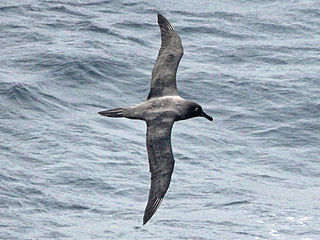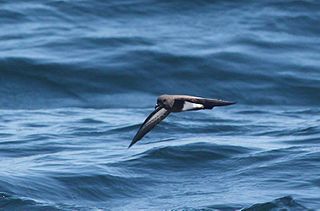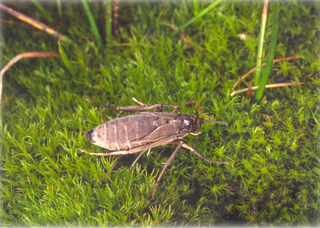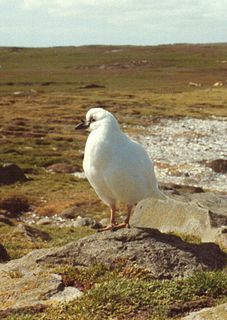 W
WThe grey-headed albatross also known as the grey-headed mollymawk, is a large seabird from the albatross family. It has a circumpolar distribution, nesting on isolated islands in the Southern Ocean and feeding at high latitudes, further south than any of the other mollymawks. Its name derives from its ashy-grey head, throat and upper neck.
 W
WThe light-mantled albatross also known as the grey-mantled albatross or the light-mantled sooty albatross, is a small albatross in the genus Phoebetria, which it shares with the sooty albatross. The light-mantled albatross was first described as Phoebetria palpebrata by Johann Reinhold Forster, in 1785, based on a specimen from south of the Cape of Good Hope.
 W
WThe sooty albatross, dark-mantled sooty albatross or dark-mantled albatross,, is a species of bird in the albatross family. They breed on sub-Antarctic islands and range at sea across the Southern Ocean from South America to Australia.
 W
WThe wandering albatross, snowy albatross, white-winged albatross or goonie is a large seabird from the family Diomedeidae, which has a circumpolar range in the Southern Ocean. It was the last species of albatross to be described, and was long considered the same species as the Tristan albatross and the Antipodean albatross. A few authors still consider them all subspecies of the same species. The SACC has a proposal on the table to split this species, and BirdLife International has already split it. Together with the Amsterdam albatross, it forms the wandering albatross species complex. The wandering albatross is one of the two largest members of the genus Diomedea, being similar in size to the southern royal albatross. It is one of the largest, best known, and most studied species of bird in the world, with it possessing the greatest known wingspan of any living bird. This is also one of the most far ranging birds. Some individual wandering albatrosses are known to circumnavigate the Southern Ocean three times, covering more than 120,000 km (75,000 mi), in one year.
 W
WThe Indian yellow-nosed albatross is a member of the albatross family, and is the smallest of the mollymawks. In 2004, BirdLife International split this species from the Atlantic yellow-nosed albatross; however Clements has not split it yet, and the SACC has not either, but recognises the need for a proposal.
 W
WThe Antarctic fur seal, is one of eight seals in the genus Arctocephalus, and one of nine fur seals in the subfamily Arctocephalinae. Despite what its name suggests, the Antarctic fur seal is mostly distributed in Subantarctic islands and its scientific name is thought to have come from the German vessel SMS Gazelle, which was the first to collect specimens of this species from Kerguelen Islands.
 W
WThe grey petrel, also called the brown petrel, pediunker or grey shearwater is a species of seabird in the Procellariidae, or petrel family. It occurs in the open seas of the Southern Hemisphere, mainly between 49°S and 32°S.
 W
WThe king penguin is the second largest species of penguin, smaller, but somewhat similar in appearance to the emperor penguin. There are two subspecies: A. p. patagonicus and A. p. halli; patagonicus is found in the South Atlantic and halli in the South Indian Ocean and at Macquarie Island.
 W
WThis is a list of the bird species recorded in the Prince Edward Islands. The Prince Edward Islands, c. 1,750 km offshore in the Roaring Forties, are near-pristine and deemed the second most important sub-Antarctic archipelago in terms of breeding birds.
 W
WThe gentoo penguin is a penguin species in the genus Pygoscelis, most closely related to the Adélie penguin and the chinstrap penguin. The earliest scientific description was made in 1781 by Johann Reinhold Forster with a type locality in the Falkland Islands. They call in a variety of ways, but the most frequently heard is a loud trumpeting which the bird emits with its head thrown back.
 W
WThe macaroni penguin is a species of penguin found from the Subantarctic to the Antarctic Peninsula. One of six species of crested penguin, it is very closely related to the royal penguin, and some authorities consider the two to be a single species. It bears a distinctive yellow crest, and the face and upperparts are black and sharply delineated from the white underparts. Adults weigh on average 5.5 kg (12 lb) and are 70 cm (28 in) in length. The male and female are similar in appearance; the male is slightly larger and stronger with a relatively larger bill. Like all penguins, it is flightless, with a streamlined body and wings stiffened and flattened into flippers for a marine lifestyle.
 W
WThe eastern rockhopper penguin is a crested penguin with yellow crest feathers. It is a subspecies of the southern rockhopper penguin found in subantarctic regions and the Indian Ocean. It is one of the smallest crested penguins and has distinctive pink margins around its bill.
 W
WThe blue petrel is a small seabird in the shearwater and petrel family, Procellariidae. This small petrel is the only member of the genus Halobaena, but is closely allied to the prions. It is distributed across the Southern Ocean but breeds at only six known sites, all close to the Antarctic Convergence zone.
 W
WThe South Georgia diving petrel or Georgian diving-petrel is one of five very similar small auk-like diving petrels of the southern oceans. It is native to the South Atlantic and islands of the southern Indian Ocean and south-eastern Australia.
 W
WThe great-winged petrel is a petrel.
 W
WThe Kerguelen petrel is a small slate-grey seabird in the family Procellariidae. The species has been described as a "taxonomic oddball", being placed for a long time in Pterodroma before being split out in 1942 into its own genus Aphrodroma. The position within the procellariids is still a matter of debate; when it was split away from the Pterodroma petrels it was suggested that it may be a fulmarine petrel, whereas a 1998 study placed the species close to the shearwaters and the genus Bulweria.
 W
WThe soft-plumaged petrel is a species of seabird in the family Procellariidae.
 W
WThe black-bellied storm petrel is a species of seabird in the family Oceanitidae.
 W
WThe grey-backed storm petrel is a species of seabird in the austral storm petrel family Oceanitidae. It is monotypic within the genus Garrodia. It is found in Antarctica, Argentina, Australia, Chile, Falkland Islands, French Southern Territories, New Zealand, Saint Helena, South Africa, and South Georgia and the South Sandwich Islands. Its natural habitat is open seas.
 W
WThe white-chinned petrel or Cape hen, is a large shearwater in the family Procellariidae. It ranges around the Southern Ocean as far north as southern Australia, Peru and Namibia, and breeds colonially on scattered islands.
 W
WPringleophaga marioni is a moth of the family Tineidae. It is endemic to Marion Island. Beside being unable to fly, this moth species is notable because of its ability to resist temperatures that are so low, that they would kill most other species.
 W
WThe fairy prion is a small seabird with the standard prion plumage of black upperparts and white underneath with an "M" wing marking.
 W
WSalvin's prion, also known as the medium-billed prion, is a species of seabird in the petrel family Procellariidae.
 W
WThe southern elephant seal is one of the two species of elephant seals. It is the largest member of the clade Pinnipedia and the order Carnivora, as well as the largest extant marine mammal that is not a cetacean. It gets its name from its massive size and the large proboscis of the adult male, which is used to produce very loud roars, especially during the breeding season. A bull southern elephant seal is about 40% heavier than a male northern elephant seal, more than twice as heavy as a male walrus, and 6–7 times heavier than the largest living terrestrial carnivorans, the polar bear and the Kodiak bear.
 W
WThe black-faced sheathbill, also known as the lesser sheathbill or paddy bird, is one of only two species of sheathbills, aberrant shorebirds which are terrestrial scavengers of subantarctic islands.
 W
WThe brown skua, also known as the Antarctic skua, subantarctic skua, southern great skua, southern skua, or hākoakoa (Māori), is a large seabird that breeds in the subantarctic and Antarctic zones and moves further north when not breeding. Its taxonomy is highly complex and a matter of dispute, with some splitting it into two or three species: Falkland skua, Tristan skua, and subantarctic skua. To further confuse, it hybridizes with both the south polar and Chilean skuas, and the entire group has been considered to be a subspecies of the great skua, a species otherwise restricted to the Northern Hemisphere.
 W
WThe subantarctic fur seal is found in the southern parts of the Indian, Pacific, and Atlantic Oceans. It was first described by Gray in 1872 from a specimen recovered in northern Australia—hence the inappropriate specific name tropicalis.
 W
WThe Antarctic tern is a seabird in the family Laridae. It ranges throughout the southern oceans and is found on small islands around Antarctica as well as on the shores of the mainland. Its diet consists primarily of small fish and crustaceans. It is very similar in appearance to the closely related Arctic tern, but it is stockier, and it is in its breeding plumage in the southern summer, when the Arctic tern has shed old feathers to get its non-breeding plumage. The Antarctic tern does not migrate like the Arctic tern does, but it can still be found on a very large range. This tern species is actually more closely related to the South American tern.
 W
WThe Kerguelen tern is a tern of the southern hemisphere.